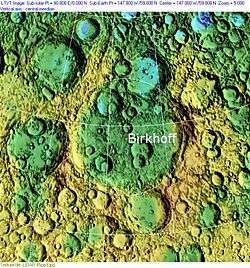Birkhoff (crater)
|
Mosaic of oblique Lunar Orbiter 5 images, facing west | |
| Coordinates | 58°42′N 146°06′W / 58.7°N 146.1°WCoordinates: 58°42′N 146°06′W / 58.7°N 146.1°W |
|---|---|
| Diameter | 345 km |
| Depth | Unknown |
| Colongitude | 156° at sunrise |
| Eponym | George Birkhoff |


Birkhoff is a giant lunar walled plain that is located on the far side of the Moon, in the northern hemisphere. This formation is an ancient impact site that has been heavily eroded, and the surface reshaped by multiple craters in the interior and along the rim. The outer wall is bordered by the craters Carnot to the south, Rowland along the west rim, and Stebbins to the north. Just to the northeast is van't Hoff.
What remains of the perimeter is now a rugged sloping rise along the inner wall, and the rim has been worn down until it is level with the irregular external terrain. The rim is pock-marked by small craters of various dimensions. Within the crater are several craters that are notable in their own right. Along the northwest inner rim is the eroded Birkhoff X, while due south in the southwest floor is Birkhoff Q. The later is joined by a low ridge to the double crater formation of Birkhoff K and L in the eastern half of the crater. In the northern interior are the smaller but relatively young Birkhoff Y and Z. The remainder of the floor is flat in places, with rough sections and many tiny craterlets.
Satellite craters
By convention these features are identified on lunar maps by placing the letter on the side of the crater midpoint that is closest to Birkhoff.
| Birkhoff | Latitude | Longitude | Diameter |
|---|---|---|---|
| K | 57.8° N | 144.3° W | 58 km |
| L | 56.6° N | 144.8° W | 37 km |
| M | 54.7° N | 144.8° W | 23 km |
| Q | 56.6° N | 150.8° W | 43 km |
| R | 57.5° N | 153.0° W | 27 km |
| X | 62.1° N | 149.7° W | 77 km |
| Y | 59.9° N | 146.6° W | 25 km |
| Z | 61.3° N | 145.3° W | 30 km |
References
- Andersson, L. E.; Whitaker, E. A. (1982). NASA Catalogue of Lunar Nomenclature. NASA RP-1097.
- Blue, Jennifer (July 25, 2007). "Gazetteer of Planetary Nomenclature". USGS. Retrieved 2007-08-05.
- Bussey, B.; Spudis, P. (2004). The Clementine Atlas of the Moon. New York: Cambridge University Press. ISBN 978-0-521-81528-4.
- Cocks, Elijah E.; Cocks, Josiah C. (1995). Who's Who on the Moon: A Biographical Dictionary of Lunar Nomenclature. Tudor Publishers. ISBN 978-0-936389-27-1.
- McDowell, Jonathan (July 15, 2007). "Lunar Nomenclature". Jonathan's Space Report. Retrieved 2007-10-24.
- Menzel, D. H.; Minnaert, M.; Levin, B.; Dollfus, A.; Bell, B. (1971). "Report on Lunar Nomenclature by the Working Group of Commission 17 of the IAU". Space Science Reviews. 12 (2): 136–186. Bibcode:1971SSRv...12..136M. doi:10.1007/BF00171763.
- Moore, Patrick (2001). On the Moon. Sterling Publishing Co. ISBN 978-0-304-35469-6.
- Price, Fred W. (1988). The Moon Observer's Handbook. Cambridge University Press. ISBN 978-0-521-33500-3.
- Rükl, Antonín (1990). Atlas of the Moon. Kalmbach Books. ISBN 978-0-913135-17-4.
- Webb, Rev. T. W. (1962). Celestial Objects for Common Telescopes (6th revised ed.). Dover. ISBN 978-0-486-20917-3.
- Whitaker, Ewen A. (1999). Mapping and Naming the Moon. Cambridge University Press. ISBN 978-0-521-62248-6.
- Wlasuk, Peter T. (2000). Observing the Moon. Springer. ISBN 978-1-85233-193-1.
